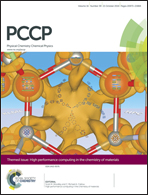Occupation matrix control of d- and f-electron localisations using DFT + U†
Abstract
The use of a density functional theory methodology with on-site corrections (DFT + U) has been repeatedly shown to give an improved description of localised d and f states over those predicted with a standard DFT approach. However, the localisation of electrons also carries with it the problem of metastability, due to the possible occupation of different orbitals and different locations. This study details the use of an occupation matrix control methodology for simulating localised d and f states with a plane-wave DFT + U approach which allows the user to control both the site and orbital localisation. This approach is tested for orbital occupation using octahedral and tetrahedral Ti(III) and Ce(III) carbonyl clusters and for orbital and site location using the periodic systems anatase-TiO2 and CeO2. The periodic cells are tested by the addition of an electron and through the formation of a neutral oxygen vacancy (leaving two electrons to localise). These test systems allow the successful study of orbital degeneracies, the presence of metastable states and the importance of controlling the site of localisation within the cell, and it highlights the use an occupation matrix control methodology can have in electronic structure calculations.

- This article is part of the themed collection: High performance computing in the chemistry of materials

 Please wait while we load your content...
Please wait while we load your content...